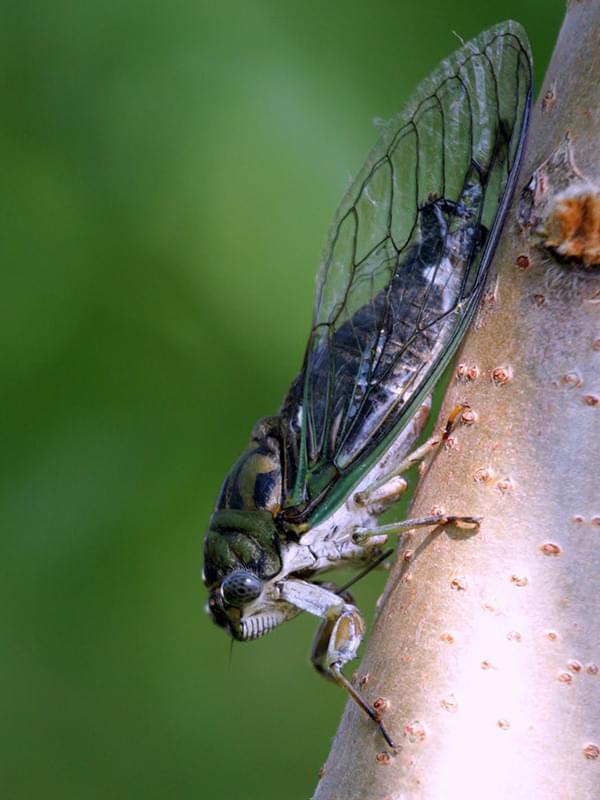Annual cicadas enliven dog days with love song

A cicada "singing" on a tree trunk
Even if the heat and humidity of recent weeks have limited your time outdoors, I bet you’ve been hearing a familiar insect song. It’s the mating call of dog day cicadas, loud enough to rise above the drone of air conditioners and so persistent and widespread that people who hear can hardly miss it.
I say, “dog day cicada” I mean the insect that goes by the two-part scientific name, “Tibicen canicularis,” which is the most common species of forest dwelling cicada that occurs in the eastern U.S. and Canada, one that has also adapted well to life in urban and suburban settings where enough trees grow to support it. These cicadas have bulky, bodies about an inch and a half long that are dark on top with green and white markings, and entirely white below. At rest their clear, heavily veined wings close over the back like a pitched roof and add another half inch to their length.
Some people call these and other cicadas locusts, a name that was first applied to them by settlers of European extraction for whom the emergence of large broods called to mind the plagues of the Bible. But the name locust is more properly applied to certain grasshoppers. Other people know cicadas by the name “harvestfly,” which derives from the fact that they emerge as adults at the same time crops are maturing.
The singing of dog day cicadas is one of the loudest insect noises on earth, sometimes exceeding 110 decibels up close. This means the song of a cicada perched your shoulder would be plenty loud to damage your hearing. The song is often compared to the whirring of a circular saw, although I think that comparison ought to be reversed, since cicadas have been around far longer than power tools. The earliest fossil record of a cicada dates back 65 million years.
The fact that dog day cicadas are also called annual cicadas sometimes generates confusion about their life cycle, but do they live for more than a year. They start out as tiny nymphs, which hatch from eggs laid in tree branches. These nymphs drop to the ground and burrow down to find a root they can latch onto for nourishment, and there they remain, probably for something like two to five years. (Scientists aren’t sure exactly how long, and the span probably varies according to conditions affecting the cicada’s development.) Some annual cicadas emerge as adults each year because their generations are staggered, which sets them apart from periodical cicadas, generations of which mature in synch, on 13- and 17-year cycles.
It is a common misperception that adult cicadas do not feed, but the fact is they have all the mouthparts needed to extract liquid from plants, and they’re not afraid to use them. Dog day cicadas do no damage to trees as they feed, and no measures to control them are warranted.

A newly captured and paralyzed cicada in the grip of a cicada killer wasp
The only warm-blooded predators that pose a significant threat to cicadas are birds, but there’s another insect that specializes in them, the cicada killer wasp. A female cicada killer stings a cicada to paralyze it, then carries it back to her burrow still alive. There she seals the unlucky creature in a chamber with one of her eggs, to become nourishment for the grub that hatches.
But that’s not where I want to leave you. Let’s get back to cicadas singing their love song in trees, and appreciate how that enriches our summer.

